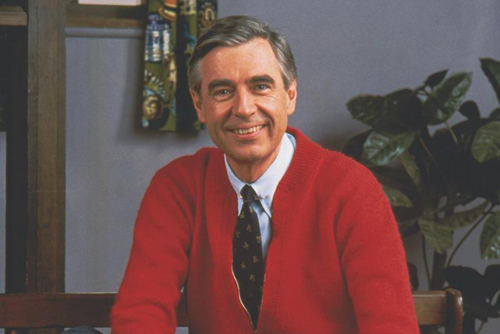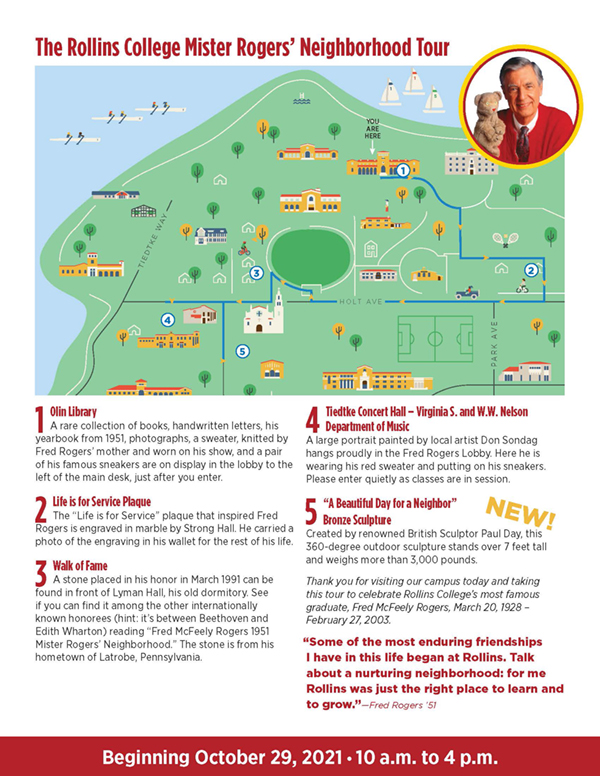In a world filled with angst as we volley through this seemingly never-ending pandemic, a new sculpture located at Rollins College in Winter Park honoring Mister Rogers’ legacy reminds us the importance of being kind and how we could all use a little more Mister Rogers in our life.
Rollins College in Winter Park is pleased to announce the installation of a new bronze sculpture “A Beautiful Day for a Neighbor,” thanks to the British artist Paul Day, which honors beloved alumnus Fred McFeely Rogers. But, perhaps, what is most important is what the deeply thoughtful and expertly crafted sculpture represents – a gentle reminder for all of us to be better people in such a trying and challenging time.
Mister Rogers once said, “We live in a world in which we need to share responsibility. It’s easy to say ‘It’s not my child, not my community, not my world, not my problem.’ Then there are those who see the need and respond. I consider those people my heroes,” and these words still ring true.
In a world plagued by a pandemic that has taken over 727,000 lives, according to the Center for Disease Control and Prevention, and conversations of vaccine efficacy, labor shortages, mailing delays, social injustice, political polarization, racial inequality and economic disruption, the new Mister Rogers sculpture is a welcomed change of scenery.
“This inspirational sculpture will be a permanent reminder of the ideals and values modeled by Mister Rogers as he set out to make the world a better place,” says Rollins President Grant Cornwell. “This tribute will reinforce the quest for empathy, acceptance and kindness so needed in our society today.”
Mister Rogers created the impactful series “Mister Rogers’ Neighborhood,” which was designed to teach children critical emotional and social skills by talking about difficult topics such as death, bullying and divorce. It taught children that what they felt was ok to feel, whether that be anger, jealously or depression, but that it wasn’t an excuse for bad behavior. It taught children that the most important characteristic of a person was to be kind. Above all else – be kind.

Although Mister Rogers accepted all religious beliefs, as an ordained Presbyterian minister who was of strong Christian faith, he took many of his life lessons taught through his program from scripture, including taking care of the most vulnerable, which could be applied to who are most vulnerable to the COVID-19 pandemic, including children, the elderly and those who are immunocompromised.
“He never liked to talk about himself but he always liked to talk about others and how we can help others,” says John Rogers, Mister Rogers’ son.
Mister Rogers came to Winter Park from Latrobe, Pa., to earn a bachelor’s degree in music from Rollins College in 1951, and he developed his unique worldview and curated his positive attitude while studying on campus.
“There is a plaque here at Rollins that states ‘Life is for Service,’ and service was always ingrained in him as he was involved in many different community organizations and committed to showing the world more kindness and selflessness, but Rollins helped reinforce that for him,” says Gisela Carbonell, Curator at the Cornell Fine Arts Museum at Rollins College.
“Aside from the importance of service, he always saw the good in people and believed being kind could change the world. He used to say that there are three things in human life that are important: The first is to be kind. The second is to be kind. And the third is to be kind,” says Carbonell.
Today, Mister Rogers’ nephew, Daniel Crozier, Theory and Composition
Professor at Rollins College, teaches the very subject that his uncle studied in college.
“An important part of my job here at Rollins is keeping the legacy of Fred Rogers alive,” says Crozier. “And not just at Rollins, but everywhere. We need his influence. Maybe now more than ever.”
Crozier and Mister Rogers bonded through their love of music. Mister Rogers spent his summers in Nantucket, Mass., working on scripts and Crozier would be there, too, during the summers.
“A lot of our closest time was spent together working on compositions or playing piano. Music is my life, it is what I do, and I think we really connected through our love of composition,” says Crozier. “One of my favorite memories of him was just talking to him. About life. About everything. I miss just talking with him. He always thought about things differently than anyone else I knew. He had a different take on situations. He didn’t get into politics much, but he was very much into making right and moral decisions.”

The sculpture, which took 23 months of dedication from conception to completion, is located in the Chapel Garden courtyard of Rollins College next to the Annie Russell Theatre. Standing over seven feet tall and weighing more than 3,000 pounds, the sculpture depicts Mister Rogers in his iconic sweater and sneakers, surrounded by children, hand puppets from “Mister Rogers’ Neighborhood,” lyrics from the series’ theme song and the show’s Neighborhood Trolley.
Sculpture artist Paul Day says, “I hope people feel the characters in the sculpture come alive in some way. It was my intent to capture the children as real people with emotions, wit, curiosity and worries – much like how Mister Rogers saw and treated children. And I hope that there is that sense of nostalgia. That the parents of today who were the children of yesterday can enjoy introducing their children to Mister Rogers and his characters. And I hope it serves as a reminder for everyone to be a good neighbor, much like Fred wanted us to be.”
Around Winter Park and the College, Rogers is still revered. The Winter Park Boat Tour script includes mention of the house on Osceola Avenue that Rogers and his wife would rent during winters after they became snowbirds in their later years.
Rogers would work on scripts for the show, rekindle old friendships and make new ones in the same place that helped launch his career.
Beginning October 29, 2021, guests are welcome to explore the neighborhood that shaped Mister Rogers on a self-guided walking tour (maps available at Rollins College) where they will experience the new bronze sculpture, exclusive Mister Rogers memorabilia and artwork, and get a feel for how Mister Rogers has left a lasting impact in the community – and beyond.





Comments